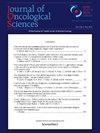Benefits and Toxicity of Taxane Addition to Platinum- Fluoropyrimidine Combination in Gastric Cancer Patients with Peritoneal Metastasis
Q4 Medicine
引用次数: 0
Abstract
ABS TRACT Objective: In advanced gastric cancer (AGC), peritoneal metastasis (PM) is associated with poor prognosis and worse perfor- mance status (PS), which makes chemotherapy administration difficult. However, PM can present with many different clinical pictures. The aim of this study was to investigate the benefits and toxicity of taxane addition to platinum-fluoropyrimidine combination in clinically poor (CPPG) and good prognostic groups (CGPG) of AGC patients with PM. Material and Methods: A total of 172 AGC patients with PM who were treated with taxane plus platinum plus fluoropyrimidine (TPF) or platinum plus fluoropyrimidine (PF) were included in the study. The patients with massive ascites or PS 2-3 or inadequate oral intake were included in the CPPG group, while those with an absence of these clinical factors were included in the CGPG group. The efficacy and toxicity of dose intensity on survival were evaluated separately for each group using the Kaplan-Meier method. Results: At the baseline, 16.9% of all patients had massive ascites, 30.2% had PS of ≥ 2, and 33.7% had inadequate oral intake. Accordingly, 50.6% of the patients were in CPPG. The overall survival times were found to be similar in patients treated with TPF as well as those treated with PF. Moreover, the addition of taxane treatment did not have any effect on either the poor prognostic group or the good prognostic group. However, as the dose intensity was increased, the grade 3/4 toxicity, dose delay, and reduction rates also increased. Conclusion: Addition of taxane to PF did not contribute to survival in AGC patients with peritoneal metastasis, independent of the clinical prognostic group.紫杉烷加铂-氟嘧啶联合治疗胃癌腹膜转移的益处和毒性
目的:在晚期胃癌(AGC)中,腹膜转移(PM)与预后差、运动状态差(PS)相关,给化疗给药带来困难。然而,PM可以表现出许多不同的临床表现。本研究的目的是探讨紫杉烷加铂-氟嘧啶联合用药对临床不良组(CPPG)和预后良好组(CGPG) AGC合并PM患者的益处和毒性。材料与方法:本研究共纳入172例AGC PM患者,分别采用紫杉烷+铂+氟嘧啶(TPF)或铂+氟嘧啶(PF)治疗。将大量腹水或ps2 -3或口服摄入不足的患者纳入CPPG组,而不存在这些临床因素的患者纳入CGPG组。采用Kaplan-Meier法分别评价各组剂量强度对生存期的疗效和毒性。结果:基线时,16.9%的患者存在大量腹水,30.2%的患者PS≥2,33.7%的患者存在口服摄入不足。因此,50.6%的患者处于CPPG。研究发现,接受TPF治疗的患者的总生存时间与接受PF治疗的患者相似。此外,添加紫杉烷治疗对预后不良组和预后良好组都没有任何影响。然而,随着剂量强度的增加,3/4级毒性、剂量延迟和减少率也增加。结论:紫杉烷加入PF对AGC腹膜转移患者的生存无促进作用,独立于临床预后组。
本文章由计算机程序翻译,如有差异,请以英文原文为准。
求助全文
约1分钟内获得全文
求助全文
来源期刊

Journal of Oncological Sciences
Medicine-Oncology
CiteScore
0.10
自引率
0.00%
发文量
16
审稿时长
29 weeks
 求助内容:
求助内容: 应助结果提醒方式:
应助结果提醒方式:


